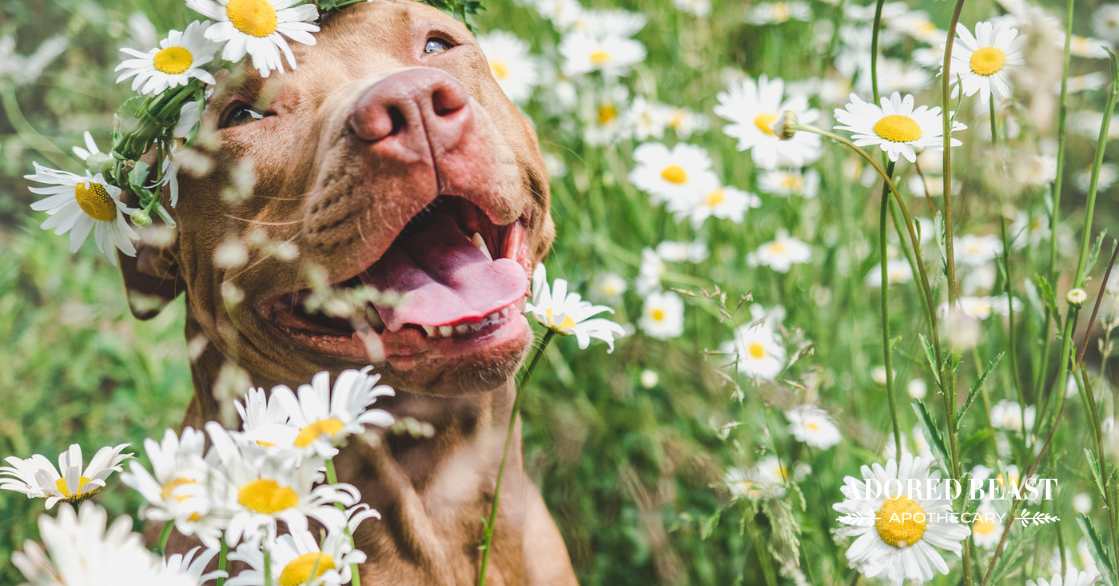Here at ABA we talk a lot about the different bounties given to us by Mother Nature, and the various ways we can use them to help support our animals naturally, whether to aid with healing or to promote general wellness.
And one that we’ve somehow managed to miss thus far is chamomile for dogs…
That was, until now!
This week we’re taking a look at the beauty of this simple plant and the many reasons we keep it on hand in our house.
What is Chamomile?
Chamomile is the common name for several daisy-like plants of the family Asteraceae. Two of the species, Roman chamomile and German chamomile, are commonly used for herbal therapies. Its name comes from the Greek word “khamaimelon,” which means “earth apple.” Chamomile got its name because it has a faint apple scent.
Chamomile has long been a celebrated herb for healing. In fact, it is actually one of the oldest medicinal herbs known to mankind! Chamomile was described in ancient medical writings and was an important medicinal herb in ancient Egypt, Greece, and Rome.
The dried flowers of chamomile contain many terpenoids and flavonoids with various values, and they contribute to the many beneficial properties of the plant, including:
- anti-inflammatory
- anti-anxiety
- antispasmodic
- anti-microbial
- antioxidant
NOTE: Chamomile can be very helpful for kitties, but how we use it is very different, particularly the amounts. Stay tuned for a blog specific to them!
The Benefits of Chamomile for Dogs
There are many reasons we keep chamomile on hand for our dogs. It’s a very versatile plant that’s been well researched for its many uses!
But before we start, as with any herb, some dogs may have an allergy to chamomile. If you know your dog is allergic to daisies, please don’t use chamomile. We recommend testing externally (on the skin) first. On a small, visible area (the tummy is usually a good spot), take a small drop or two of a chamomile tincture or cool, brewed chamomile tea. If you don’t notice any reaction (rash, bumps, redness, itching, excessive licking, welts), you can move ahead with using it both internally and externally, as needed.
Also, if your animal is new to chamomile, you may want to start small, with a quarter of the recommended amount, and work your way up.
**Try to use a high quality, organic chamomile.
1. Anxiety
There’s a reason many people turn to chamomile tea before bed, or after a particularly stressful day. It’s well known for its relaxing properties, and that’s why it’s a common suggestion for natural anxiety relief, both for people and pets.
Chamomile is an easy way to help calm your pup when she is stressed or anxious. A chamomile tincture directly in the mouth, or added to food, or some chamomile tea on its own or with food are all ways to use it this way. 1-2 teaspoons for small dogs, 1-2 tablespoons for large dogs. You can also use homeopathic chamomile in this case!
Did You Know: Homeopathic chamomile is also great for teething puppies to help calm them and give them some relief!
2. Tummy Trouble
Because of its soothing anti-inflammatory properties, chamomile can be helpful for an upset stomach, vomiting, indigestion, or acid reflux. It can be helpful for reducing inflammation in the digestive tract, calming it down.
Most dogs don’t mind the taste, and will happily take it with their regular food. Some will even lap it up all on its own.
- Tea: 1-2 teaspoons for small dogs, 1-2 tablespoons for large dogs, 1-2 times daily.
- Glycerin Tincture: 0.25 – 0.5mls per 20lbs of bodyweight, 1-2 times daily, as needed.
3. Skin Irritation and Inflammation
Again, we go back to those soothing, anti-inflammatory properties. Externally, chamomile can not only soothe irritated skin but also help promote wound healing.
You can make a pot of strong chamomile tea and let it cool, then use either the teabag itself or a piece of gauze pad or an organic washcloth as a compress on hot spots, rashes, bug bites, or other skin irritations. (Don’t use regular cotton pads or cotton balls – these can stick to the area!)
If your dog suffers from environmental allergies, a rinse after a romp outside, especially in the spring or fall, will help keep the skin microbiome intact but get rid of some of the environmental allergens. Make a rinse with 1/4 tea to 3/4 water. Pour it on and just let it soak in – don’t rinse it off.
4. Anal Gland Issues
Those two small glands near the bum can be troublesome for many dogs. If your dog tends to suffer from anal gland issues, using chamomile as part of your regimen is a good idea. Apply a compress with green and chamomile tea to the anal glands to help soothe them. An epsom salt compress may also help.
Let your dog choose if they want a warm (not hot) or cold compress. Some will want warm, some will want cold. Warm will help express the glands by drawing out the fluid but cold can help bring down the inflammation and soothe the area. Sometimes starting with cold and switching to warm is the best solution, but let your dog decide.
5. Worms
Our good friend, canine herbalist Rita Hogan, recommends chamomile as a natural alternative for worms in dogs, specifically round and whipworms!
Rita says, “Chamomile helps dogs who are prone to round and whipworms. It’s anti-spasm, anti-inflammatory, and easy on the gut. Combine chamomile with other herbs like elecampane, neem leaf, and olive.”
Her recommendations:
- Tincture: Give a chamomile tincture twice daily, 1 drop for every 10 lbs of bodyweight. If using you’re using a glycerine extract, double the amount.
- Tea: 1 Tablespoon dried chamomile for 8 ounces of almost boiling water steeped 30-45 minutes. Let cool and give over food. Add spent dried herb to food. Give 1 tsp per 10 lbs of bodyweight.
6. Eye Issues
Yet again we look to the anti-inflammatory properties of chamomile here, along with the fact that is is very soothing. This makes it the perfect, gentle herb for the eyes.
Chamomile may help with swelling and inflammation of the skin around the eye. It’s gentle, and won’t sting. Brew a strong cup of chamomile tea and let it cool, then use the teabags as a compress and gentle hold on the eye. You can do this a few times a day.
A Few Final Things…
Chamomile is considered a safe herb. It is very gentle, and most dogs don’t mind the taste or have any issues with it.
That said, we don’t recommend it for long-term internal use. Instead, simply use it when needed.
It’s safe for puppies, but don’t use it with pregnant or lactating dogs.
Are there any drug interactions you should be aware of? Use caution with chamomile if your cat is on any of the following medications: warfarin, NSAIDs, or any sedatives.
As always, if you have any concerns at all, speak to a canine herbalist or with your holistic veterinarian.
Chamomile for dogs is yet another of Mother Nature’s wonders, one we are so thankful to have in our first aid kit. The next time your pup is dealing with one of the above issues, consider this pretty plant on your path to health and healing.












